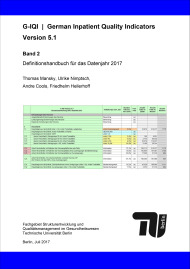G-IQI – German Inpatient Quality Indicators. Version 5.1 – Band 2
Definitionshandbuch für das Datenjahr 2017
Editor: Andre Cools, Friedhelm Hellerhoff, Ulrike Nimptsch, Thomas Mansky

Publishing year: 2017
The German Inpatient Quality Indicators (G-IQI) have been developed for measuring outcome and volume indicators for specified diseases and/or procedures based on administrative data. In Germany the administrative billing data of the hospitals (the so called DRG-data) are electronically exchanged with the insurance companies and also once a year delivered to the federal office of statistics via standardized data interfaces (specifications according to § 21 KHEntgG and § 301 SGB V; this data transfer includes all somatic patients, all payers and all hospitals). G-IQI provide medically meaningful information about important and/or frequent diseases and procedures, which are treated or performed, respectively, in German hospitals. Wherever possible and medically sensible, information concerning outcome is provided besides volume indicators. In many cases this is the in-hospital mortality for the specific disease or procedure. This volume presents the revised G-IQI version 5.1 together with the technical specifications based on the German coding systems for the data year 2017. As compared to the preceding version 5.0 various indicators have been modified or more precisely specified. Some additional indicators have been added. However, the major innovation in this version is the introduction of aggregate indicators. For certain disease groups (like diseases of the heart) these allow to assess aggregate hospital performance in this area via three dimensions: Range of provided services, volume, and outcome, where available. The evaluation is based on a comparison of the indicators of a single hospital versus the national distribution of these indicators. Details of this method will be described in a subsequent publication. The G-IQI indicators cover more than 50% of all in-patient cases in Germany. This is more than for other disease specific indicator systems. The in-hospital mortality indicators cover over 59% of all in-hospital deaths. Indicator systems like G-IQI can be used for public reporting. In this way G-IQI is used by the ‘Initiative Qualitätsmedizin’, an association of more than 400 German and Swiss hospitals publishing their results based on these indicators. Furthermore the Swiss Bundesamt für Gesundheit uses a Swiss variant of these indicators (CH-IQI) for an obligatory public reporting for all Swiss hospitals. Predominantly, however, G-IQI indicators are used within the internal quality management of the hospitals for continuous improvement of medical outcomes. Results which deviate from the federal average may and should be a reason for investigating the treatment processes of the respective disease, which may, for example, involve peer reviews of medical records. By using the indicators as a trigger tool it is possible to install an efficient and highly effective outcome oriented quality management within a hospital.



